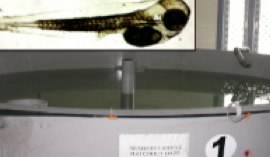Asian Seabass Seed Production Technology
|
Indigenous System
Brood Stock Development
- Brood fish size 2-7 kg
- Water exchange @ 70% daily – good quality sea water (28-32 ppt)
- Feed trash fish @ 5 % body weight
- Prophylatic treatments with 100 ppm formalin
- Monitor maturity regularly
Spawning and Incubation
- Gravid female (ova diameter >0.45mm)
- Hormone LHRH @ 60-70 μ/kg for females and half the dose for males
- Spawning after 30-36 hr
- Egg deansity 500 numbers/ litre
- Larvae hatch after 15-17 hrs
Larval Rearing
- Larval density @30/litre
- 3rd -10th day –feed rotifers @ 20-30 /litre
- Water exchange @ 40% daily
- Add green water and quality sea water
- 11th – 15th day – feed Artemia nauplii and rotifer
- 16th – 25th day – only Artemia nauplii
- Transfer larvae (15mm) to nursery
Improved System
Recirulatory Facility
- Water biosecurity & automation
- Brood stock maturation – recirculation, salinity and temperature manipulation
- Reduced stress & extended spawning period
- High larval density(100 larvae/litre)brood fish size 2-7 kg
- Quality seed (30mm) production
| ECONOMICS (Rupees for 1 million production capacity) |
| Input |
Indigenous |
Improved |
| Hatchery construction (lakhs) |
59.00 |
100.00 |
| Running cost/year (lakhs) |
12.38 |
20.00 |
| Seed sale price (Rs/piece) |
2.25 |
4.00 |
| Gross income (lakhs) |
22.50 |
40.00 |
| Net income (lakhs) |
10.12 |
20.00 |
|

|
 |
 |
 |
Top
Source:
Central Inland Fisheries Research Institute (ICAR)
Barrackpore, Kolkata -700 120,
West Bengal.
Updated on Jan 2015
|

